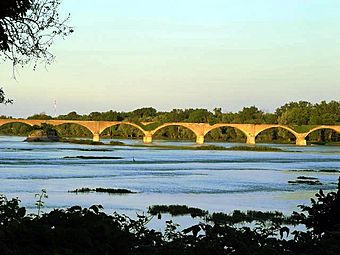Interurban Bridge facts for kids
Quick facts for kids |
|
|
Interurban Bridge
|
|

Interurban Bridge and Roche de Bout
|
|
| Nearest city | Waterville, Ohio |
|---|---|
| Built | 1908 |
| Architect | National Bridge Co. |
| NRHP reference No. | 72001036 |
| Added to NRHP | June 19, 1972 |
The Interurban Bridge is a really old bridge in Ohio. It was built in 1908. It's also known as the Ohio Electric Railroad Bridge. This bridge crosses the Maumee River, connecting Lucas and Wood counties near Waterville, Ohio.
When it was built, it was the world's largest earth-filled reinforced concrete bridge. One part of the bridge sits on a famous rock called Roche de Boeuf. This rock was a historic meeting place for Native Americans. Some of the rock was changed when the bridge was built. The bridge is no longer used by trains. Today, it's a popular spot for photographers and artists. They often visit Farnsworth Metropark to see it.
Building the Bridge: Lima-Toledo Traction
The Interurban Bridge has been empty for many years. It was built by a company called Lima-Toledo Traction. This company ran an "interurban" trolley line in the early 1900s. An interurban was like a streetcar, but it traveled longer distances between cities.
The Lima-Toledo line went from Toledo to Lima, Ohio. From Lima, it connected to another line that went to Springfield. Many interurban lines in Ohio had money problems. To try and fix this, Lima-Toledo Traction joined with other Ohio interurban companies. They formed a larger network called the Ohio Electric corporation. All their trains were renamed "Ohio Electric."
However, this big company also struggled financially. In 1921, Ohio Electric went bankrupt. The Lima-Toledo line went back to its original owners. It continued to run trains between Toledo and Lima. The Interurban Bridge was very important for this route.
Last Train Rides: Cincinnati and Lake Erie Railroad
In 1929, the Lima-Toledo line joined with two other interurban companies. They formed a new, much larger railroad called the Cincinnati and Lake Erie Railroad (C&LE). This new company had 323 miles of track. It offered train service from Toledo all the way to Cincinnati. There was also a branch line to Columbus, Ohio's capital.
The C&LE wanted to carry more passengers and freight. Freight means goods or products. This part of Ohio had many factories. From 1929 to 1930, the C&LE spent a lot of money. They fixed their tracks and bought new trains. They wanted to offer fast service between major cities like Toledo, Lima, Springfield, Dayton, and Cincinnati.
At first, the C&LE was successful. Business grew, especially for freight. But then the Great Depression hit. This was a time when the economy was very bad. Many people lost their jobs. The C&LE also faced other problems. There were floods that damaged their tracks. More and more cars and trucks started using new paved roads. This meant fewer people and goods traveled by train.
Because of these problems, the C&LE lost money. They had to stop running trains in 1937. This was the last year any trains crossed the Interurban Bridge. On June 19, 1972, the bridge was added to the National Register of Historic Places. This means it is recognized as an important historical site.



